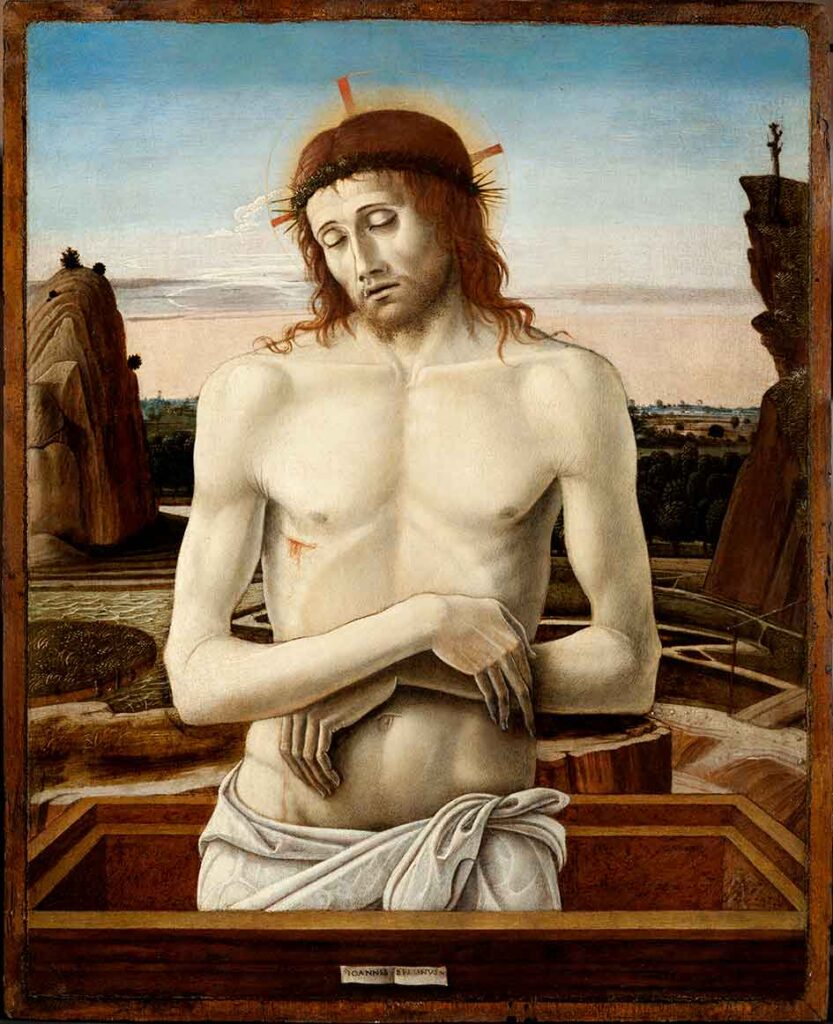Imago Pietatis
Giovanni Bellini , ca. 1457
Description

Jesus, showing the pallor of death, rises from the tomb. The side walls of the sarcophagus, drawn in perspective, invite the viewer’s eye to explore the painting, along the walkway on the right crossing the stream, beyond the woods, to the horizon illuminated by the light of dawn.
On either side there are two high rocks. On top of them, a dry tree on the right evokes death and sin, while the leafy plants on the left probably evoke the rebirth of nature and the redemption of humankind through the sacrifice of Jesus. An iconographic peculiarity, still not clear, is the lack of the stigmata on Christ’s hands, while the wound on his torso is evident.
The landscape shows a sequence of parallel horizontal planes, against which the sorrowful figure of Christ stands out. The unifying element of the entire composition is the diffuse light, which invests the body as well as every other element of the surrounding nature, silent and participating, in an atmosphere of desolate solitude.
This moving painting, datable to around 1457, belongs to Giovanni Bellini’s early production, when the artist was still strongly influenced by the models of his brother-in-law Andrea Mantegna.
Data Sheet
Author
Giovanni Bellini, 1430-1516
Date
ca. 1457
Material and technique
Tempera on panel
Measures
50 cm x 40.4 cm
Acquisition
Gian Giacomo Poldi Pezzoli bequest, 1879
Inventory number
1587
location
Golden Room
The Golden Room is the most important room in the Museum and houses the masterpieces of painting from the Poldi Pezzoli collection. Conceived according to the dictates of the Renaissance style, it was designed to be the hall of honor of Gian Giacomo’s apartment. After the collector’s death, Giuseppe Bertini carried on the work: unfortunately, both the gilded coffered ceiling, the frescoes, painted by Bertini himself, and the damask fabric decorations that lined the walls were destroyed by bombing. The current museographic arrangement dates back to the 1990s. Among the works on display are the Portrait of a Lady attributed to Piero del Pollaiolo and which has become a symbol of the museum, Bellini’s Imago Pietatis, Botticelli’s Lamentation over the Dead Christ, Mantegna’s Madonna and Child, and Piero della Francesca’s Saint Nicholas of Tolentino. The display case separating the Salone Dorato from the Sala degli Stucchi houses the porcelain and majolica collections.
collection
Paintings
The Museum hosts over 300 paintings. Among them, many Italian works from the Renaissance: masterpieces from Tuscany (Botticelli, Piero della Francesca, Pollaiuolo), Lombardy (Luini, Boltraffio, Solario) and Veneto (Bellini, Mantegna). Important is also the group of 18th century Italian painting (Guardi, Canaletto, Tiepolo, Fra Galgario). In the collection, there are mainly portraits and small size paintings.
